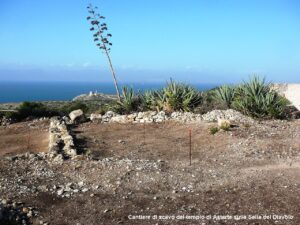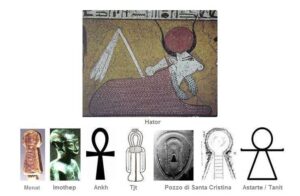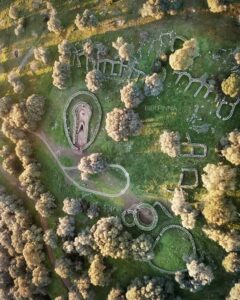The ruins of the temple of Astarte are visible on the summit of the Sella del Diavolo in Cagliari. This Phoenician deity, identifiable with the Punic Tanit, represented the mother goddess but was also associated with fertility, love, and pleasure. It is therefore not a coincidence that in its temple of “Sella” it is believed that sacred prostitution was practiced. Religious syncretism linked Astarte/Tanit to other deities such as the Greek Aphrodite and the Roman Venus, but also to other divine figures of the Egyptian pantheon like Maat, who presided over the west, Mut (mother), and finally the lunar goddess Isis, who was in turn associated with Hator.
It is therefore not a coincidence that in its temple of “Sella” it is believed that sacred prostitution was practiced. Religious syncretism linked Astarte/Tanit to other deities such as the Greek Aphrodite and the Roman Venus, but also to other divine figures of the Egyptian pantheon like Maat, who presided over the west, Mut (mother), and finally the lunar goddess Isis, who was in turn associated with Hator. Isis had as her emblem the knot “Tjt” (fourth figure at the bottom), but shared with Hathor a metallic rattle called “Sistrum” and the counterweight Menat (with relative necklace), which appears above the neck of the goddess Hathor herself, depicted below in the form of a “celestial cow”.
Isis had as her emblem the knot “Tjt” (fourth figure at the bottom), but shared with Hathor a metallic rattle called “Sistrum” and the counterweight Menat (with relative necklace), which appears above the neck of the goddess Hathor herself, depicted below in the form of a “celestial cow”.
The “menat” is particularly the first object depicted at the bottom but also appears in the second figure around the neck of Imhotep, vizier and architect of Pharaoh Djoser of the III dynasty (2630-2611 BC). The third image is that of the “ankh,” a typical Egyptian emblem of “life.”
Returning to us, the fifth and sixth figures represent the sacred well of S. Cristina in Paulilatino and a horizontal section of it, while lastly appears the emblem of Astarte/Tanit. I believe it is even superfluous to highlight how all these symbols seem to possess a similar meaning and are still connected to the sexual sphere, as are the various deities listed; and it is, in fact, a shared opinion that the “menat”, the symbol of Astarte, and the planimetric layout and section of the sacred well depict the external female genitalia.
I believe it is even superfluous to highlight how all these symbols seem to possess a similar meaning and are still connected to the sexual sphere, as are the various deities listed; and it is, in fact, a shared opinion that the “menat”, the symbol of Astarte, and the planimetric layout and section of the sacred well depict the external female genitalia.
It cannot therefore be surprising that the apical hole of the well of S.Cristina was oriented to intercept the lunar rays during certain periods, as Isis, Hathor, and Astarte are essentially lunar goddesses (but also linked to the solar cycle). The reference to the female genitalia is, among other things, confirmed by the name of the goddess Hator, which transliterated from the hieroglyphs reads Hwt-Herw (Huteru = house of Horo).
The reference to the female genitalia is, among other things, confirmed by the name of the goddess Hator, which transliterated from the hieroglyphs reads Hwt-Herw (Huteru = house of Horo).
The photos of the well temple nuragic of Santa Cristina, in Paulilatino, are by Bibi Pinna.

